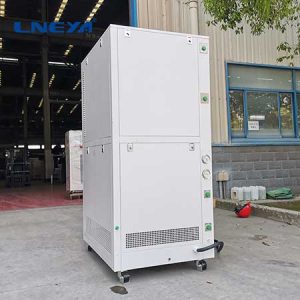What should we do if there is liquid flowing in the chiller laboratory?
① Cracks or perforation caused by corrosion of plates due to improper selection of plates.
② The operating conditions do not meet the design requirements.
③ Residual stress after cold stamping and too small clamping size in assembly cause stress corrosion.

④ Slight leakage is found at the plate leakage groove, causing harmful substances (such as C1) in the medium to concentrate and corrode the plate, forming a cross flow.
1. Treatment method for liquid spilling in FL +5°C ~ +35°Cウォーターチラー:
① Replace the cracked or perforated plates and find the cracks on the plates by light transmission method on site.
② Adjust the operating parameters to meet the design conditions.
③ The clamping size of the heat exchanger during maintenance and assembly shall meet the requirements, not the smaller the better.
④ Reasonable matching of plate materials in cooler laboratory

2. How to prevent damage to the cooler laboratory?
There are many sources of cooler vibration, and one or several of them may be the source of harmful vibration. The pulsation caused by reciprocating machinery is a source of excitation.
However, some vibrations transmitted from supporting members or connecting pipes are another source of excitation. Because these types of excitation source frequencies are determined by the system, they are relatively predictable. However, the mechanism of hydrodynamic excitation is difficult to predict.
(1) Reduce the linear velocity of the shell side. When the flow path cannot be changed, the tube center distance can be increased or the shell diameter can be increased

(2) The effective way to improve the natural frequency of the pipe is to shorten the maximum unsupported span length of the pipe or change the pipe material to increase the wall thickness, but the effect is not as significant as method (1).
(3) Changing the form of baffle plate or using baffle rod can also change the arrangement of tubes on the premise of meeting the requirements of heat transfer and pressure drop
(4) When the nozzle vibrates, the diameter of the nozzle can be increased.
 LNEYA
LNEYA
 简体中文
简体中文


















































































